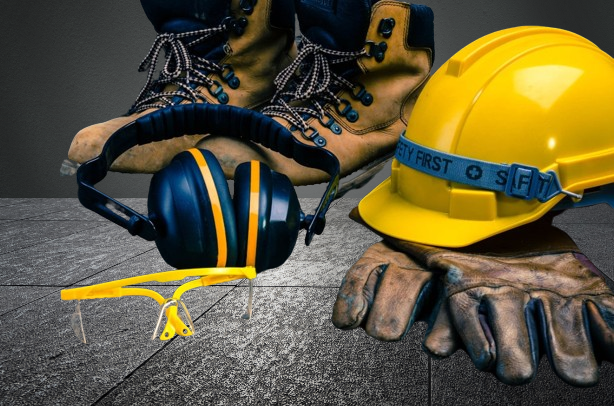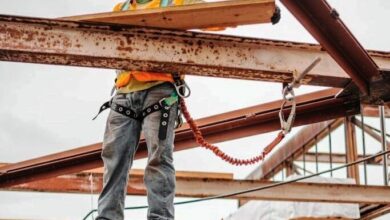Essential Construction Safety Measures

In the US, there are three construction worker fatalities on job sites every day on average. This alarming figure emphasizes the ongoing need for safety enhancements that give priority to construction workers, who each year account for one out of every five work-related fatalities in the United States.
Luckily, we are aware of the risks associated with construction sites, so we know exactly what to anticipate and how to get ready for it. For the employees under their supervision, construction managers who take construction site safety seriously can have a significant impact.
Construction workers can enjoy safer and more productive work sites by implementing safety protocols that address common construction hazards like falls and best practices like effective communication.
Here is a list of nine crucial construction site safety tips that you should follow.
1. Avoid Falls
Since falls cause over one-third of all construction-related fatalities, fall prevention needs to be a top priority on any construction site. All falls are avoidable with the correct tools and procedures, which translates into lifesaving.
Among the most important components of any fall prevention program are:
- Practice good form: According to the “three points of contact” rule, which increases stability and lowers risk, three limbs should always be in contact with the surface you are standing or climbing on.
- Employ safety equipment: To prevent falls from dangerous heights, personal fall arrest systems (PFAS) and harnesses for scaffolding workers are essential.
- Select the appropriate gear: Reducing unneeded falls requires using the proper ladder and knowing when to use a lift rather than scaffolding.
Safe construction sites will not only follow these important guidelines but also appropriately signpost high-risk areas, such as leading (unprotected) edges where fall protection is necessary. Construction managers can significantly improve the safety of their sites in terms of fall prevention by implementing a few simple adjustments.
2. Put in Place Excellent Training
For many reasons over the last thirty years, there has been a steady decline in construction accidents; however, OSHA’s emphasis on hiring competent and qualified personnel is among the most significant. Qualified workers rely on formal education to make safe and informed decisions, while competent workers are able to adjust to changing conditions on a construction site.
Always take the following actions to ensure that your workforce is qualified and competent:
- Offer ongoing instruction: Providing employees with regular training opportunities helps to maintain current and relevant safety knowledge.
- Conduct routine knowledge assessments: To identify any gaps in your workers’ safety knowledge, conduct oversight and spot checks on a regular basis.
- Establish a mentorship initiative: Assist newly hired employees on your job sites in getting used to certain safety procedures by assigning them to more seasoned team members.
The greatest chance for safety is to have a thorough awareness of both the unique risks associated with a construction site and your own role within it. Consider that a well-informed team is more likely to be safe and productive, preventing accidents and meeting deadlines, rather than seeing training as interfering with the construction process.
3. Make Use of Modern Equipment
Although training can have a significant impact on job site safety, malfunctioning or antiquated tools, such as table saws and large machinery like rollers, can be the cause of some accidents. When purchasing equipment for your site, take into account your options because modern equipment frequently has improved safety features.
Remember the following when using construction equipment:
- Do daily safety checks: Make sure all equipment is in good operating order by following a list of daily safety checks before using it.
- Establish a regular maintenance schedule: To avoid deterioration that could pose a safety risk, all equipment must have a defined maintenance schedule.
- While buying equipment can be a wise investment, renting equipment allows you to always have access to the newest features and to precisely what you need for every task.
Giving your employees the greatest equipment possible reduces the possibility of an unintentional malfunction that could cause harm or even death. Construction workers’ safety ultimately depends on the tools and equipment they use every day to finish their jobs, regardless of how cautious or well-trained they are.
You can improve site safety by purchasing high-quality equipment and setting up processes for routine maintenance and daily inspections.
4. Examine Wearable Construction Equipment
Although many safety concerns have long-standing solutions, personal construction wearables offer new avenues for worker protection. Better versions of current footwear, such as boots and gloves, are starting to surface with added safety features.
These are just a handful of the wearables used in construction that are changing the way we perceive safety on the job site:
- Smart hard hats are designed to reduce the risk of dangerous collisions between workers and vehicles. They do this by utilizing sensors both inside the helmet and in heavy machinery.
- Wearables that track activity and health: Smartwatches monitor vital signs and GPS location, which enhances the safety of lone workers and helps to monitor worker fatigue.
- AR safety glasses give important details. Although they are not yet fully developed, augmented reality (AR) safety glasses promise to give users instant access to safety information, such as the location of hazardous materials or leading edges.
The field of construction wearables is expanding rapidly; in addition to the above-mentioned gadgets, there are smart boots that can identify falls and body monitors that can identify hazardous gas concentrations. Even on construction sites, intuitive noise-canceling headsets can lessen noise pollution while facilitating communication among teammates.
You can start investing in these technologies as a construction manager to implement the safety of the future on your site.
5. Engage in Appropriate Communication
Because construction workers come from a variety of backgrounds and specializations, it is essential to have excellent communication skills to make sure that everyone is on the same page. In order to keep everyone safe when dangerous situations arise, clear communication is essential. Clear communication can also help mitigate risky situations.
Think about putting these best practices for communication on your website:
- Create a clear chain of command. This will help employees understand who they are reporting to and supervising, which will help when they receive contradicting information.
- Restrict the use of jargon: Technical language, or jargon, differs amongst specialties, so when attempting to communicate on the spot, using precise descriptions is more beneficial.
- Promote open communication: Ineffective or dangerous circumstances may go unreported at a workplace if employees are afraid to speak up. Establish a respectful listening culture to encourage employees to speak up.
In addition to these pointers, getting ready for a bilingual workplace is another crucial component of communication in the US construction industry. According to a Forbes report, 21% of American workers believed that misunderstandings resulting from language barriers made them less safe.
You can improve both productivity and job site safety by placing a high priority on clear communication.
6. Be Disaster-Ready
All across the nation, natural disasters pose a threat to lives and property, so workers and construction sites need to be on high alert. Disaster preparation is an essential component of construction safety, regardless of whether the area around your site is prone to earthquakes, hurricanes, or tornadoes.
When getting ready for a natural disaster, remember to take the following into account:
- Establish safe areas on the property: Identify areas that, in the event of a natural disaster, are safe from danger.
- Pay attention to utilities: Recognize where gas and electric lines are located on your property because they may be damaged in many natural disasters.
- Make an escape strategy: Establish an off-site meeting place for all staff in case the construction site becomes uninhabitable.
Certain natural disasters, like earthquakes, are less predictable than others, but some give advance notice. For the sake of everyone’s safety, close down the construction site in situations that seem dangerous. Create a safety plan to completely prevent dangerous conditions for construction workers, such as strong winds, heavy precipitation, and lightning strikes.
7. Increase Mental Health Awareness
In addition to the numerous physical risks they work in, construction workers’ jobs also have a negative impact on their mental health. One in four construction workers are thought to suffer from a mental illness, and the sector has one of the highest suicide rates. The need to take care of employees’ mental health will be taken into account in any discussion of construction site safety.
To address the psychological requirements of construction workers, bear the following concepts in mind:
- Inform your staff about the warning signs and symptoms. Initiatives such as Mental Health First Aid enable staff members to identify coworkers’ signs of anxiety and depression so they can take appropriate action.
- Offer mental health coverage: More and more businesses are realizing that adequate health insurance for construction workers needs to cover benefits for treating mental illness.
- Be mindful of substance abuse: 15% of construction workers struggle with substance abuse due to the physically demanding nature of their jobs. Provide direction and assistance to these people.
Establishing a safety culture necessitates figuring out how to shield employees from all threats, including the possibility of psychological difficulties. Make an effort to create a work atmosphere that recognizes the particular challenges faced by construction workers and to supply the tools required to maintain their well-being.
8. Revise COVID-19 Protocols
The COVID-19 pandemic has brought safety for construction workers back into the spotlight. The pandemic’s particular concerns have also made new safety procedures necessary that weren’t previously thought of. The knowledge that construction managers gain from keeping their employees safe during the pandemic will be beneficial for overall safety going forward.
Keep in mind the following as you continue to oversee the health and safety of your employees:
- Provide appropriate personal protective equipment (PPE): To help stop the spread of disease, all employees must have consistent access to masks, gloves, and hand sanitizer.
- Implement contact tracing: In the event of a positive test, construction workers can wear small devices on their clothing to help provide contact tracing, reducing the spread and preventing full-blown outbreaks.
- Practice social distancing: Although construction work is necessary during the pandemic, workers can remain safe and productive by altering the way they complete tasks.
Construction managers who put worker safety first in all their decisions tend to be the most successful. You’ll be sending a clear message to your employees that you’re looking out for their best interests by making an effort to stop the COVID-19 virus from spreading on your property.
9. Continue to follow your safety plan
The creation of a safety plan, a crucial document, is the foundation for all of the previously mentioned advice. Every construction site needs to have a thorough safety plan that covers all of the above and more. The document should also be dynamic—it should be updated frequently to reflect modifications to staff or protocol.
A safety plan ought to at least include the following information:
- The duties of the representative for site safety
- How and when safety inspections will take place
- Details regarding safety instruction Particular elements of safety procedures relevant to the given work location
- Recording of regional safety laws
- How mishaps and urgent medical situations will be resolved
- When will the plan be updated and reviewed?
Though specifics vary by site, a truly comprehensive safety plan will contain much more information. All safety plans, however, share a strong dedication to putting worker safety first above all else.
You can foster a culture of continuous improvement by periodically evaluating your position on safety. The construction sector will persist in its efforts to eradicate mishaps and fatalities while safeguarding its most valuable resource: laborers.

